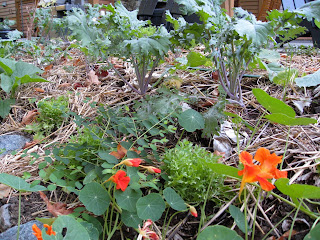2014
3 years 3 months after the emergency while living outside wrapped around the Indian plum I brought the 3 afternoon tea cloths inside.
They were carefully washed, dried and ironed. I was hoping the laundering had stopped the decay processes.
There is much staining and decay and large holes had appeared.
How to preserve this cloth? The usual way to repair a cloth is to darn it but the whole cloth is in such a fragile state didn't think it would support darning. Another way to repair cloth is to add a patch. When I thought about it, adding patches is the way the soil is repaired each year. Leaves fall from plants and trees and cover the soil. Organic processes work on breaking down the leaves to return them to the soil.
I was thinking about this soil repair idea when while out on a walk I noticed the Tulip tree had a skirt of leaves reflecting the shape if its branches. It was using its leaves to replenish the soil it grows in.
I looked more closely at those fallen leaves and saw the majority had decayed in such a way that only the veins were left. They were leaf skeletons.
I collected them up and soaked them in water to remove the soil and pine needles.
I left them to dry.
They are quite lovely in their fragile state. I had this idea to repair the tea cloth with these fragile leaves. I hand stitched leaves directly onto the cloth over the holes. At the top of the cloth I stitched a row of eyelets, wove a jute string through them and inserted a stick I found near the Tulip Tree.
The cloth hung on my design wall for the year, still too delicate to do anything with.
2015
When the Tulip tree was dropping its leaves again the next year made me look again at the still fragile afternoon tea cloth.
I wanted to add more leaves but I wanted to make the skeletons stronger while still appearing fragile. It was time to sample. I coated leaves with various mediums but they tended to fill the holes and look a bit shiny. I ironed on a fine fusible web. I liked the look.
I added the bonded leaves but I couldn't iron them in place. I decided to machine sew them in place using the finest thread I had with the finest needle. I liked what was happening and decided to add another layer of leaf skeletons next fall.
2016
I added another layer of bonded leaves using a combination of hand and machine stitching.
The cloth with its leaves was stronger looking but getting very dried out and brittle. I added a thin layer of liquid Min Wax. I thought this last effort had ruined the whole thing. It was shiny and stinky and ugly. I just left it hanging thinking I would throw it away when I got around to it.
But one day it caught my eye because it had taken on a transparent glow and the layers of leaves were more visible giving an interesting depth. And it wasn't stinky anymore.
I was going to add yet another layer of leaves until it got accepted into the World of Threads Festival. Once our work is accepted we have to promise the work shipped will be exactly the same as the images we sent in with the application.
I can add the next layer of leaves after it returns home.
PS This is what the Indian plum tree looks like fall 2016
Still alive...
...but the bark doesn't look very healthy where the deer ate it.
The fungus growth on the middle trunk indicates the tree is dying.
Maybe the deer knew the tree was old and on its way out.



















































